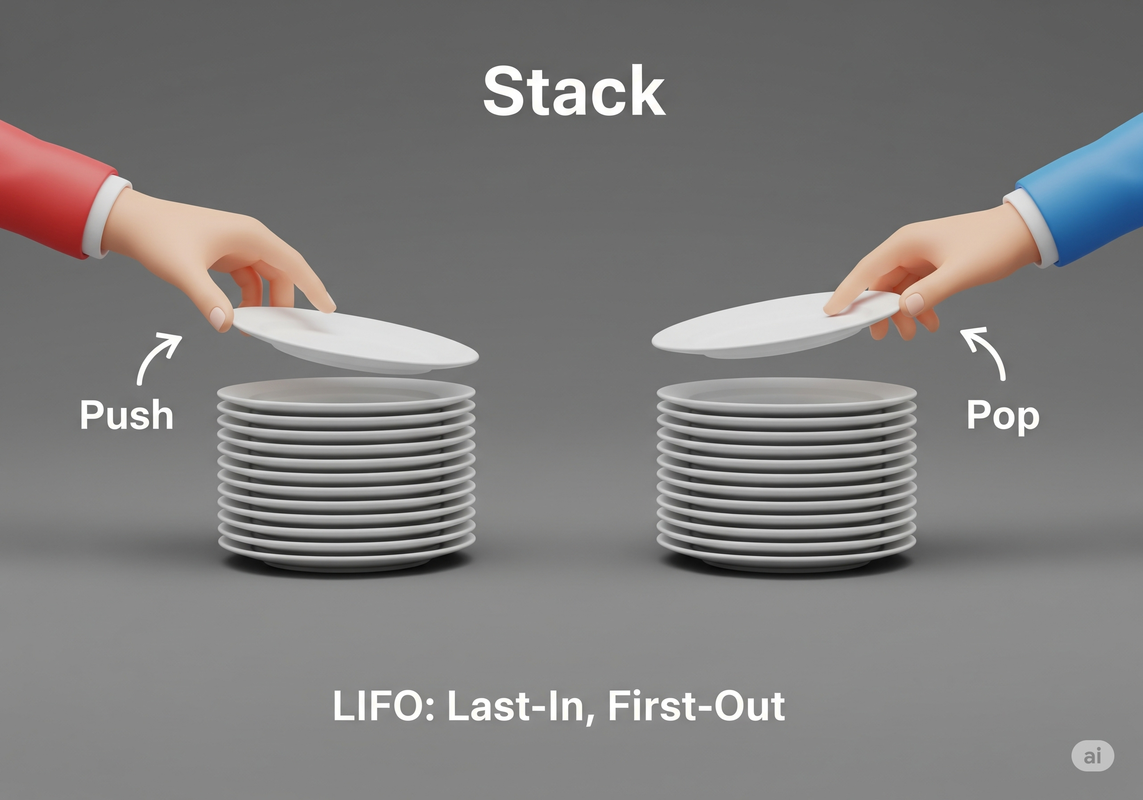Blueprint 5: "The Command Spire" 📚
Blueprint 5: "The Command Spire" 📚
1. The Mission Briefing: A Problem of Reversal
"Architect, when navigating complex nested systems, we often need to perform a series of actions and then undo them in the exact reverse order. We need a data structure specifically designed for this 'Last-In, First-Out' (LIFO) behavior."
Imagine you are piloting a drone through a narrow canyon. You make a series of turns: Left, Right, Right, Left. If you hit a dead end, how do you backtrack? You must undo your last turn first (Left), then the one before that (Right), and so on.
An Array or a Linked List could store this path, but they aren't specialized for this specific "reverse order" task. For this, we need a more elegant tool: the Stack.
2. The Analogy: A Stack of Plates
A Stack is exactly like a stack of plates in a cafeteria.

Think about how you interact with it. You can only add a new plate to the top of the stack, and you can only take a plate from the top. You can't pull a plate from the middle or the bottom without the whole thing crashing.
This simple but strict rule is the core of the Stack data structure. The last plate you placed on the stack is always the first one you take off. This is the LIFO principle.
3. Visualizing the Operations
The two primary operations on a stack have special names:
- Push: Placing a new item onto the top of the stack.
- Pop: Removing the top item from the stack.
These operations are extremely fast, taking O(1) (Constant Time) because they never depend on how many items are already in the stack. You're always just working with the top.
Interactive Stack (LIFO) Simulation
Visualize the Last-In, First-Out principle of a stack.
Stack is empty
4. Implementing a Stack: The Blueprints
A Stack is more of a concept than a specific structure. You can build it using other data structures, most commonly an Array or a Linked List.
Method 1: Using an Array (The Simple & Common Way)
Modern programming languages have dynamic arrays (like Python lists or JavaScript arrays) that make implementing a stack incredibly easy. We can simply use the built-in push and pop methods that already work on the end of the array.
Code Example: Array-Based Stack
class Stack:
def __init__(self):
self.items = []
def push(self, item):
self.items.append(item)
def pop(self):
if not self.is_empty():
return self.items.pop()
return None
def peek(self):
if not self.is_empty():
return self.items[-1]
return None
def is_empty(self):
return len(self.items) == 0
def size(self):
return len(self.items)Method 2: Using a Linked List (The Classic & Efficient Way)
Implementing a stack with a linked list is a classic computer science exercise. It's highly efficient because, unlike a dynamic array that might occasionally need to resize (a costly operation), a linked list's push and pop (inserting/removing at the head) are always guaranteed to be O(1).
Push Operation (Linked List)
Pop Operation (Linked List)
5. The Architect's Toolkit: Core Stack Operations
Every standard Stack implementation, regardless of how it's built, should have these methods:
| Method | Description | Analogy | Time Complexity |
|---|---|---|---|
| push(item) | Adds an item to the top of the stack. | Placing a new plate on top. | O(1) |
| pop() | Removes and returns the top item. | Taking the top plate off. | O(1) |
| peek() | Returns the top item without removing it. | Looking at the top plate. | O(1) |
| isEmpty() | Returns true if the stack has no items. | Checking if there are any plates. | O(1) |
| size() | Returns the number of items on the stack. | Counting the plates. | O(1) |
6. Common Use Cases (In the Labyrinth and on Earth)
The LIFO principle of stacks makes them incredibly useful for many problems:
- The Function Call Stack: The most fundamental use! When a function A calls function B, B is pushed onto the call stack. When B finishes, it's popped off, and control returns to A. This is how your computer keeps track of where it is in a program.
- Undo/Redo Functionality: Every time you perform an action in a text editor, that action is pushed onto a stack. When you hit "Undo," the action is popped off and reversed.
- Expression Evaluation: Compilers use stacks to evaluate mathematical expressions (converting from infix "5 + 3" to postfix "5 3 +").
- Backtracking Algorithms: In a maze, a stack can be used to keep track of the path taken. If you hit a dead end, you pop from the stack to go back to the last decision point.
7. Blueprint Summary
Concepts Unlocked: Stacks, LIFO (Last-In, First-Out), push, pop, peek, isEmpty, size, Array-based implementation, common applications.